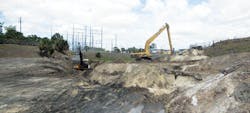Making the Grade
Woodsmere Pond, located in unincorporated Orange County, Fla., has no natural outfall. The pond is 5 acres in size with very steep side slopes and receives floodwater from a 2,300-acre watershed. In 1960, the watershed was flooded after Tropical Storm Donna, which resulted in the construction of a pump station and associated outfall in 1965 to control the flood stage.
The Woodsmere Pumping Station consists of three separate pump systems and has a capacity of 19,000 gal per minute, discharging eastward through approximately 2,600 ft of initially 36-in., then 42-in. ductile iron pipe, connected in a series. The system’s outfall into Lake Lawne Outfall Canal eventually flows to the Little Wekiva River. Because this system serves a densely populated area, the pipe system is inspected and cleaned every three years to ensure the outfall system functions.
Woodsmere Pond collects storm water from a high-traffic four-lane divided highway as well as several commercial and residential areas. Because of the compact population density of these contributing areas, large amounts of floating and submersible debris flow into the pond, creating sediment buildup.
Cleaning Up
The pump station has limited access resulting from its close proximity to a fire station building abutting the pond. This, together with the pond depth, steep slopes and vertical concrete walls along the perimeter, made it difficult to access for trash removal and regular maintenance.
A heavy equipment crew, pump station staff and engineers explored ways to direct the debris to a selected area along the pond’s edge, but many options were not feasible because of flow velocity, access constraints, labor intensity and cost of maintenance. One option to collect the trash/debris was to install a fence around the perimeter of outfall from Silver Star Road, but steep slopes, depth and adequate accessibility to remove the debris made this option infeasible. Staff also approached the Florida Department of Transportation (FDOT) to install trash collectors in its inlets, as most of the debris came from its upstream pipe system along the Silver Star roadway, which finally reaches the pond through a large box culvert. But with funding unavailable and other field and maintenance constraints, FDOT could not accommodate the request.
Over the past few years, staff attempted several small retrofits to address the selected areas of the pond slope failures, but despite piecemeal remediation of the slopes, failure repeated itself due to sandy soil and steep geometry.
Sedimentation Increases
In 2011 and 2012, because of low rainfall, more pronounced areas of slope failures and larger volumes of sediment were noticeable. To remedy the failing slopes, they explored the possibility of installing cable concrete, but it was not recommended for such steep slopes. In addition, mowing and spraying operations became difficult due to access, depth and steepness of side slopes.
Because the accumulated sediment and debris also had reduced the storage capacity of the pond, staff decided to remove the sediment from the bottom of the pond and regrade, bench and re-sod the slope to break the adverse slope. Due to the high cost of outsourcing this work inclusive of dredging, retrofit of the pond was performed by the in-house heavy equipment crew. Dredging activity would increase the capacity of the pond and the reshaping of the pond would aid maintenance once the adverse slope was corrected.
Staff approached permitting agencies, including the Florida Department of Environmental Protection and the St. Johns River Water Management District, which did not see any major permitting issues because this was a closed basin. In-house staff and the Florida Department of Environmental Protection inspected the project construction to ensure compliance with all local and state regulations.
The dredging and regrading operation was performed by a crew ranging from six to nine staff members. The crew utilized a variety of equipment, including long and short boom excavators, a backhoe, dump trucks, 6-in. pumps, pickup trucks and flat beds. The primary scope of the project included removing two 5-ft areas of sediment from the bottom of the pond, regrading the slope from a 2:1 to 3:1 gradient, and building a maintenance berm across the central access berm along deeper sections of the pond and around the perimeter for ease of access and future maintenance. This work was performed with minimal impact to surrounding commercial and residential neighborhoods. Several outfall structures within the pond had to be modified to match new bottom elevation and reduce erosion due to splashing. Splash pads and rock rubble were used to address the erosion control at mitered end sections of the outfall pipe.
Challenges
During the dredging process, several challenges were encountered, including unsuitable soils, which required deeper excavation. Due to the steep slope, depth and the adjacent roadway, a transitional access roadway had to be carved out to facilitate the hauling out of unsuitable material and trucking in of suitable fill. In addition, a few days of heavy rainfall resulted in some washout of the pond slopes and required the high water levels to be managed and turbidity to be monitored, all of which delayed the projected completion time of the project.
The Woodsmere Pond project was completed in November 2013, integrating varying slopes that would allow easy access to equipment and be less likely to fail; it also now is an aesthetically pleasing pond with higher capacity. From the inception of the project to final completion, it took 60 days at a cost of $170,000.
Deodat Budhu, P.E., is manager for the Orange County (Fla.) Public Works Department. Budhu can be reached at [email protected]. Mehul J. Parekh, P.E., is chief engineer for Orange County Public Works Department. Parekh can be reached at [email protected].
Download: Here


